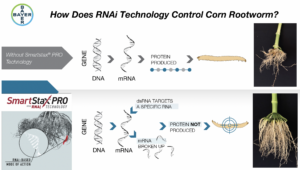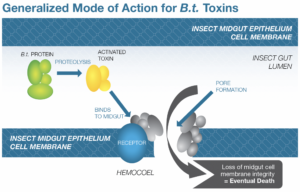The understanding of RNAi (ribonucleic acid interference) technology begins with an understanding of DNA (deoxyribonucleic acid) and RNA (ribonucleic acid). Living organisms are comprised of genes which are made from long molecules (DNA) that provide the information needed to create the proteins that are necessary for life. Each DNA molecule has two molecular strands (double stranded or double helix) that are connected to each other like ladder rungs. Each piece of the genetic code controls or manages a certain function within animals, plants, and other organisms.
DNA never leaves the nucleus of each cell; therefore, a single-stranded messenger RNA (mRNA) molecule carries the instructions from the genetic code to
the cytoplasm where proteins are produced. When protein-producing structures within the cytoplasm receive the mRNA code, the structures react by producing a specific protein which may or may not be essential for the organism to survive.
RNA interference (RNAi) refers to the ability of small pieces of RNA to shut down, or silence, a gene in response to an endogenous (internal) or exogenous (external) trigger. Cells naturally contain RNAi mechanisms that are triggered by double-stranded RNA (dsRNA) to safeguard RNA from “compromised” mRNA. Compromised mRNA, such as a virus, may mimic the good mRNA; however, RNAi mechanisms can distinguish the difference and interfere with, silence, or destroy the compromised mRNA. Knowing this can occur, scientists can now use RNAi to insert specific dsRNA (double stranded RNA) or DNA that when transcribed produces dsRNA to manage or silence the specific function of an RNA link. In the case of corn rootworm (CRW), RNAi technology can be used to silence the DvSnf7 mechanism that allows rootworms to produce an essential protein.
How does SmartStax® PRO Technology use RNAi technology?
The DNA of a western corn rootworm (WCR) (Diabrotica virgifera virgifera LeConte) contains a genetic code for a protein, Snf7, which is essential for its survival.
Through RNAi technology, a targeted piece of DNA has been inserted that encodes for a piece of the CRW Snf7 gene. When RNA is transcribed from the DNA in the corn plant, the RNA folds onto itself forming dsRNA. When WCR ingests the DvSnf7 dsRNA, its cellular machinery separates the two strands of dsRNA and matches one strand with the CRW Snf7 mRNA. When this occurs, an enzyme chops up the mRNA, preventing the essential Snf7 protein from being produced (Figure 1).
Combined Technologies
SmartStax® Technology uses biotechnology to insert two CRW-specific events into a corn plant that produce Bacillus thuringiensis (B.t.) proteins (Cry34Ab1/35Ab1 and Cry3Bb1) within the plant tissue. When B.t.-protected corn root tissue is ingested by the rootworm larvae, the ingested B.t. proteins cause pore formation in the midgut of the rootworm larvae resulting in the death of the insect (Figure 2).
SmartStax® PRO corn products combine the proven benefits of SmartStax® technology with an additional RNAi-based mode of action (MOA) to provide three modes of action (MOA) for corn rootworm control. Both SmartStax and SmartStax PRO technologies provide three B.t. MOA (Cry1A.105, Cry2Ab2 and Cry1F) for European corn borer, Southwestern corn borer, and fall armyworm protection. Additionally, they have two MOA for corn earworm and one MOA for black cutworm protection. Both technologies also have glyphosate and glufosinate herbicide tolerance.

Figure 1. Depiction of required protein being produced by a rootworm via mRNA protein message (top) and not being produced (bottom) because the rootworm has ingested the RNAi messenger protein.

Figure 2. Depiction of how consumed corn rootworms perish when they consume root tissue from B.t.-protected corn plants.
Sources:
Younis, A., Siddique, M.I., Kim, C., and Lim, K. 2014. RNA interference (RNAi) induced gene silencing:
A promising approach of Hi-Tech plant breeding. International Journal of Biological Sciences. Volume 10. Ivyspring International Publisher. https://www.ncbi.nlm.nih.gov/pmc/articles/PMC4202031/.
Yan, S., Ren, B., Zeng, B., and Shen, J. 2020. Improving RNAi efficiency for pest control in crop species. BioTechniques®, Volume 68, No. 5. Future Science. https://www.future-science.com/doi/pdf/10.2144/btn-2019-0171.
Zhang, J., Khan, S.A., Heckel, D.G., and Bock, R. 2017. Next-generation insect-resistant plants: RNAi-mediated crop protection. Trends in Biotechnology. Volume 35, Issue 9. Science Direct.
Bolognesi, R., Ramaseshadri, P, Anderson, J., Bachman, P., Clinton, W., Flannagan, R. Ilagan, O., Lawrence, C., Levine, S., Moar, W., Mueller, G., Tan, J., Uffman, J., Wiggins, E., Heck, G., and Segers, G. 2012. Characterizing the mechanism of action of double-stranded rna activity against western corn rootworm
(Diabrotica virgifera virgifera LeConte). PLoS ONE 7(10): e47534. Doi:10.1371/journal.pone.0047534. https://www.researchgate.net/publication/232257452_Characterizing_the_Mechanism_of_Action_of_Double-Stranded_RNA_Activity_against_Western_Corn_Rootworm_Diabrotica_virgifera_virgifera_LeConte.
Websites verified 7/19/2022.
Legal Statement
Bayer is a member of Excellence Through Stewardship® (ETS). Bayer products are commercialized in accordance with ETS Product Launch Stewardship Guidance, and in compliance with Bayer’s Policy for Commercialization of Biotechnology-Derived Plant Products in Commodity Crops. Commercialized products have been approved for import into key export markets with functioning regulatory systems. Any crop or material produced from this product can only be exported to, or used, processed or sold in countries where all necessary regulatory approvals have been granted. It is a violation of national and international law to move material containing biotech traits across boundaries into nations where import is not permitted. Growers should talk to their grain handler or product purchaser to confirm their buying position for this product. Excellence Through Stewardship® is a registered trademark of Excellence Through Stewardship.
SmartStax® PRO corn products will be commercially available for the 2022 growing season.
ALWAYS READ AND FOLLOW PESTICIDE LABEL DIRECTIONS. B.t. products may not yet be registered in all states. Check with your seed brand representative for the registration status in your state.
IMPORTANT IRM INFORMATION: RIB Complete® corn blend products do not require the planting of a structured refuge except in the Cotton-Growing Area where corn earworm is a significant pest. See the IRM/Grower Guide for additional information. Always read and follow IRM requirements.
Performance may vary, from location to location and from year to year, as local growing, soil and weather conditions may vary. Growers should evaluate data from multiple locations and years whenever possible and should consider the impacts of these conditions on the grower’s fields.
Roundup Ready® 2 Technology contains genes that confer tolerance to glyphosate. Glyphosate will kill crops that are not tolerant to glyphosate. Herculex® is a registered trademark of Dow AgroSciences LLC. LibertyLink® and the Water Droplet Design® is a trademark of BASF Corporation. Respect the Refuge and Corn Design® and Respect the Refuge® are registered trademarks of National Corn Growers Association. Bayer, Bayer Cross, RIB Complete®, Roundup Ready 2 Technology and Design™, Roundup Ready® and SmartStax® are trademarks of Bayer Group. All other trademarks are the property of their respective owners. ©2022 Bayer Group. All rights reserved. 1219_24950

